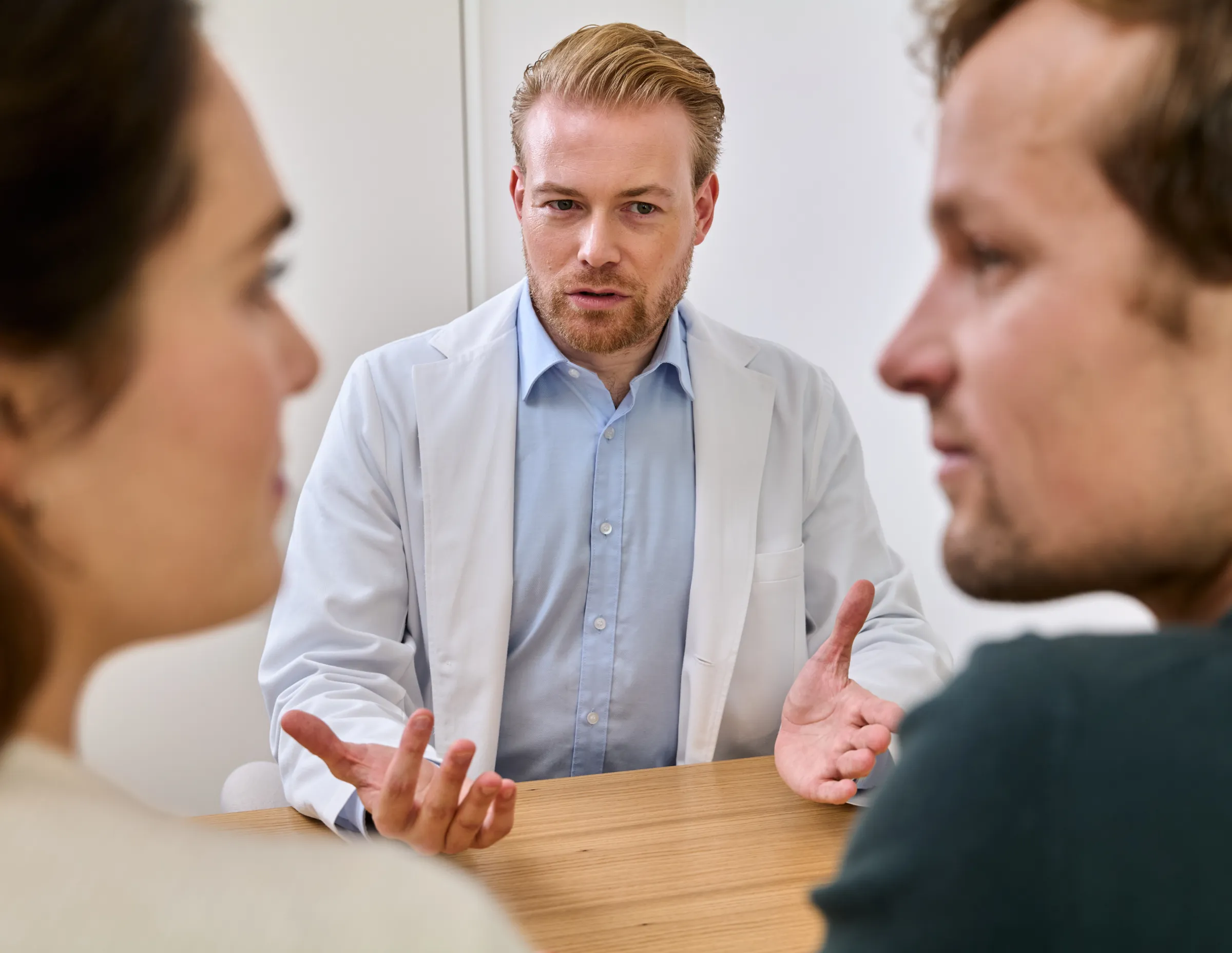An overview of testicular hypofunction: its symptoms, causes, and effects on male fertility. Learn about what treatments are available for the condition.
Introduction
What is testicular hypofunction? Also known as male hypogonadism, this endocrine condition affects males, and involves insufficient production of testosterone, sperm, or both.
The World Health Organization’s International Classification of Diseases (ICD-10; ICD-11) recognizes two main forms of testicular dysfunction: testicular hyperfunction and testicular hypofunction. In this article, we take a deep dive into the latter condition, examining the symptoms, the causes, and the effects that it has on male fertility. Let’s start by looking at the anatomy.
What are the testes, and what do they do?
The testes, or testicles, are the male gonads. They are a pair of organs located inside the scrotum, the thin bag of skin that surrounds and protects them. They have two main functions:
- synthesizing testosterone, the most important sex hormone in males (it is produced by females, too, but in much smaller amounts); and
- producing sperm, which are critical for male fertility.
Testosterone and sperm production
The production of both testosterone and sperm begins in the brain, at the top of the hypothalamic-pituitary gonadal (HPG) axis, with the brain signaling the hypothalamus to secrete gonadotropin-releasing hormone (GnRH). This in turn, stimulates the pituitary gland to release the gonadotropins, follicle-stimulating hormone (FSH) and luteinising hormone (LH). The latter travels through the blood to the testes, where it acts on the Leydig cells, stimulating them to produce testosterone by converting cholesterol.
Both testosterone and FSH then stimulate spermatogenesis, the process by which male germ cells (spermatogonia) develop into mature sperm (spermatozoa) that are capable of moving towards and fertilising a female ovum. Spermatogenesis occurs within the seminiferous tubules, a system of tubes within the testes.
Apart from helping to produce sperm, testosterone plays a number of roles in male puberty, including:
- Development and enlargement of the penis and testes
- Deepening of the voice
- Growth of facial, axillary (armpit) and pubic hair
- Increased muscle mass
Beyond puberty, testosterone is also important for:
- Bone growth and health
- Sex drive
- Regulation of mood
In recent years, it has become increasingly clear that beyond being a sex hormone, testosterone also helps to regulate a number of other aspects of behavior, such as aggression, and aspects of health, including metabolism, cognition, and vascular functioning.
Like most hormones, testosterone is regulated by a negative feedback mechanism which controls its production. The hypothalamus normally sends signals to the pituitary gland to make testosterone. When it detects that testosterone levels are too high, the hypothalamus alerts the pituitary gland, which then signals the testes to decrease production.
How much testosterone is normal?
Physiological testosterone levels in men are normally in the range of 300 to 1,000 ng/dL. Testosterone usually peaks in the male sex at around age 20.
When testosterone levels are discussed, often what is being measured and referred to is total testosterone, which is all of the hormone that is present in the blood. This includes both ‘free’ or unbound testosterone, which can act on tissues, and that which is bound to proteins, such as sex hormone-binding globulin (SHBG), which is not available for immediate use. Free testosterone makes up a small amount, usually less than 5% of the total testosterone, but it is highly biologically active and responsible for many of testosterone’s effects. For this reason, doctors sometimes measure free testosterone in addition to total testosterone, to gain a more complete picture of hormonal status.
It is normal for testosterone production to decrease with age. Whereas women have a more sudden decline in hormones with menopause, the decline of testosterone in men is slow and continuous over time.
What causes male hypogonadism?
There are two types of hypogonadism. While both can be characterised by low testosterone production and impairment of spermatogenesis, each has its own causes.
Primary hypogonadism, sometimes called primary testicular failure, results from a problem in the testicles. Common causes of this include:
- Klinefelter’s syndrome. In this condition, there is an abnormality of the sex chromosomes, so that instead of having only one X and one Y chromosome, a male has at least one extra X chromosome. This causes the testicles to develop abnormally and testosterone to be underproduced.
- Undescended testicles (also called cryptorchidism). Usually, the testicles develop in the abdomen, then descend into the scrotum before birth. In some cases, this does not occur. The condition may then correct itself during the first few years of life, but if not, testicular hypofunction and low testosterone can be the result.
- Mumps infection. In addition to affecting the salivary glands, mumps may also involve the testicles and cause damage to them, resulting in reduced testosterone production.
- Hemochromatosis. In this condition, there is too much iron in the blood, which can affect both the pituitary gland and the testicles.
- Testicular injury. Damage incurred to the testicles can also lead to hypogonadism. If only one testicle is injured, however, testosterone and sperm production may not be impaired.
- Cancer treatment. Both chemotherapy and radiation treatment can impact production of testosterone and sperm.
- Aging. It is normal that older men have lower testosterone levels than younger men, as production slowly and continuously declines with age. This is not considered hypogonadism. However, 20% of men above age 60, 30% of men over 70, and 50% of men over 80 have a testosterone level that is lower than normal.
Secondary hypogonadism is a condition in which the testicles are normal, but they don’t function properly due to problems originating in the the pituitary gland or hypothalamus. Causes of this include:
- Kallmann syndrome. This abnormal development of the hypothalamus can lead to male hypogonadism, as well as to anosmia, or the inability to smell.
- Pituitary disorders, including tumors in or around the pituitary gland.
- Inflammatory diseases, such as tuberculosis or sarcoidosis
- HIV and AIDS
- Certain medications, such as opiates and psychotropic medications.
- Obesity
- Excessive amounts of stress or physical activity
- Extreme weight loss
What are the symptoms?
Symptoms of insufficient testosterone production in men include:
- Decreased body and facial hair
- Reduction in muscle mass
- Reduced energy and stamina
- Low sex drive
- Sexual dysfunction, including erectile dysfunction and reduced ejaculate
- Small testicles
- Hot flashes
- Irritability
- Poor concentration
- Depression
- Osteoporosis
How is testicular hypofunction diagnosed?
A diagnosis is made based on a combination of symptoms and blood work. It often begins with clinical observation of symptoms and/or complaints from a patient.
In older men, a doctor or other health care provider may administer a test called the Androgen Deficiency in Aging Male (ADAM). This 10-item questionnaire was designed to identify older men with signs of low testosterone, and includes items about libido, strength, erections, and energy.
Blood tests for testosterone levels are ideally done in the morning, as testosterone levels can vary throughout the day, and tend to be highest in the morning. If the total testosterone level is below 300 ng/dL, it is considered to be low. Often the test will be performed on two occasions, to confirm the result.
If the result is confirmed, further tests may be done to identify whether the cause might be the testicles, or the hypothalamus or pituitary gland. These include looking at free testosterone, and at follicle-stimulating hormone (FSH) and luteinising hormone (LH) levels. Elevated FSH and LH suggest that the problem is primary hypogonadism: the testes are not able to carry out the instruction sent by the hypothalamus and pituitary gland.
In secondary hypogonadism, by contrast, levels of FSH and LH are lower than expected, suggesting that the hypothalamic message is not being sent in the first place. In addition, if the prolactin level is higher than normal, it indicates that the origin of hypogonadism may be the pituitary gland.
Does it need treatment?
What is the benefit of treating testicular hypofunction? In boys, diagnosing and treating the condition in a timely fashion can help to prevent delayed puberty and problems that this may cause. In men, treatment helps to:
- Restore libido and sexual function
- Establish or maintain virilization (adult male characteristics, such as facial hair)
- Optimise bone density and stave off osteoporosis
- Restore fertility, in the case of secondary hypogonadism
- Improve strength
- Stabilise mood
What is the treatment?
Testosterone replacement therapy
In cases where the main complaint is low testosterone production, treatment involves testosterone replacement therapy, which is available in several different formulations:
- Transdermal patches: these are applied to the skin, usually of the upper arm, abdomen or thigh, and can deliver continuous levels of testosterone into the blood for 24 hours at a time. However, skin irritation can be a common side effect.
- Topical gel: this is applied to skin outside of the genital area. It is recommended that this be applied in the morning to achieve a testosterone concentration that mimics the normal circadian pattern, in which testosterone is highest in the morning.
- Implantable pellet: this is surgically implanted and slowly releases testosterone over a period of three to six months.
- Intramuscular injections: these are often done in the buttocks or legs, at intervals of two to four weeks. They can result, however, in abnormally high levels of testosterone in the first few days after administration, and abnormally low levels by the end of the dosing interval.
- Oral tablets. These are associated with certain side effects, including gastrointestinal problems, acne, and the development of breast tissue (gynecomastia).
Men who need testosterone therapy should talk to their health care provider in order to determine which formulation is right for them.
It is important to note, however, that testosterone replacement is not a good option for men who wish to be fertile in the near future. This is because administration of exogenous testosterone (that not produced by the body) can activate the negative feedback mechanism of the hypothalamic-pituitary-gonadal axis, inhibiting the release of GnRH, FSH and LH and impairing sperm production, causing infertility.
Gonadotropin therapy
Gonadotropin therapy is the main treatment option for men with secondary hypogonadism and impaired sperm count who wish to improve their fertility. Gonadotropins are synthetic forms of the hormones produced by the hypothalamus and/or pituitary gland, such as FSH and LH. They help stimulate spermatogenesis in the same way as the hormones made by the body do. They can be administered via subcutaneous or intramuscular injection.
In one study, 112 men with low testosterone, low FSH and LH, and no sperm in their ejaculate (known as azoospermia) were given LH and FSH analogs as hormone replacement therapy. Over the course of the observation period, 96 of the 112 men (85.7%) had detectable sperm in their ejaculate.
However, the effect was not immediate, with an average of 9.48 months from initiation of treatment to appearance of sperm. Of the study participants in whom spermatogenesis was induced, 70 also wished to conceive a child; 48 (66.6%) of these succeeded in achieving conception with their partners without further intervention, with an average time of 21 months to pregnancy.
Lifestyle treatments
Guidelines offered by the UK Society for Endocrinology and the European Academy of Andrology (EAA) suggest that when men with hypogonadism are overweight or obese, lifestyle changes and weight loss should form the first approach to the problem. Weight loss alone can improve low testosterone levels. Overall, suggestions for lifestyle modifications include:
- Reducing weight, where appropriate
- Following a healthy diet
- Performing moderate exercise
- Improving amount and quality of sleep
- Decreasing stress
Commonly asked questions
Should I have my testosterone level and sperm production checked?
In general, this is not recommended for men without complaints. However, if you have concerns related to infertility or are experiencing the symptoms outlined above, your doctor or fertility specialist can help you to figure out whether testing and treatment are necessary.
What can I do to keep my testosterone and sperm production levels healthy?
While not all problems with these functions can be avoided, men can aim to support their hormone and sperm production through a healthy lifestyle. This includes maintaining a healthy weight, eating a nutritious diet, exercising, and avoiding excessive stress.
If I have testicular hypofunction, what are the odds that it can be treated?
The answer to this question depends on two things: the reason for the hypofunction, and the goals of treatment. If you have low testosterone levels and wish to improve the symptoms, testosterone replacement therapy may help. If you are instead focused on achieving fertility, and your gonadotropin levels are found to be low, you would likely instead receive gonadotropin treatment, which research has shown to be effective in restoring sperm production and fertility.
If you have primary hypogonadism (originating in the testes) and would like to get pregnant with your partner, assisted reproduction techniques may be more appropriate. A fertility specialist can help guide you through the options.
Do men go through menopause?
Unlike women, in whom decline of sex hormone production is more sudden and rapid, men tend to experience a slow decline of testosterone production over time. This is normal, and generally not something that needs to be treated, as long as testosterone remains within the normal range for age. Men also generally remain fertile for a longer portion of the lifespan compared to women.
Takeaway
In males, the testicles perform two important functions: producing testosterone and producing sperm. In testicular hypofunction or male hypogonadism, these processes can be negatively affected. The origin of this problem can be either in the brain, or in the testes themselves. Fertility can be affected via reduced sex drive and sperm production, but in some cases this can be restored via treatment with gonadotropins. Where low testosterone and its effects are the main concern, men can consider a range of options for testosterone replacement therapy.
At Cada, our team specialises in male and female fertility. We're here to hear your concerns and wishes, and to help you address them. Get in touch with us so that we can figure out the best plan for you. Reserve your spot for a personalised consultation today.







